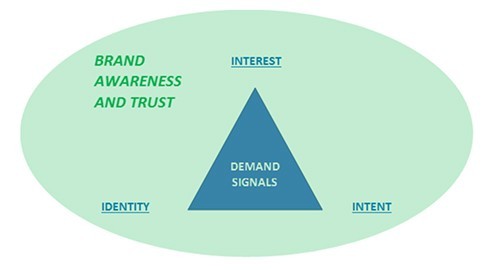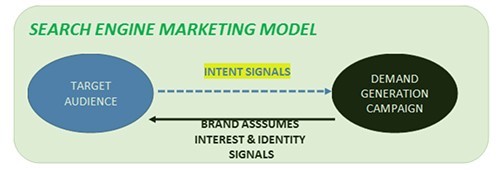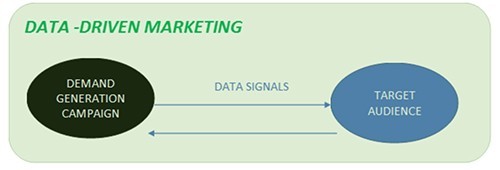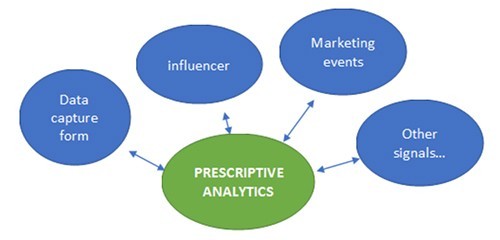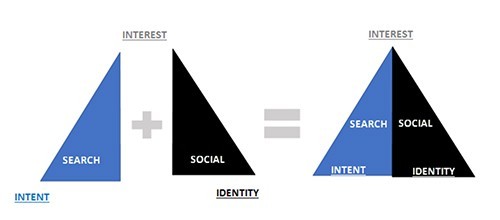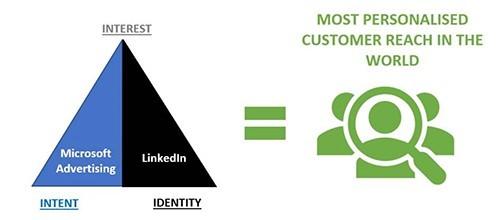It’s Time to Triangulate Marketing’s Demand Signals
Editor's Note: This guest post was contributed by Jason Miller, Head of Brand Marketing, Microsoft Advertising.
Marketers are fascinated by decision journeys. We study a lot of different shaped funnels, flow charts and diagrams illustrating how buyers purchase the things they do. We’re fundamentally interested in the different factors that shape demand for our products and services, from the first stirrings of the idea to buy or change something, all the way through to experiencing the things that we buy and evaluating whether we made the right choice — and if we’ll make that choice again in the future.
The sweet spot for demand generation marketing
We’re interested in all of these things, but when it comes down to it most of our demand generation marketing has always focused on just one part of this journey. We target the sweet spot towards the end of the initial buying process when people with buying influence have a need, and know that they have a need; when we can reach those our product or service is relevant for, at the moment when they realize that for themselves and are consciously evaluating options. The science of demand generation marketing involves identifying this sweet spot at scale — and activating against it in the most effective way possible.
We know, of course, that this isn’t everything involved in influencing buying choices. If you’re smart and interested in sustainable growth, then you’ll know the value of driving broader brand awareness over the longer term. If you have the resources to do it, then there’s real value in ensuring that when people reach the demand generation sweet spot, they’re already thinking about your business as a solution. If nothing else, you can gain a big advantage from making sure they’ve at least heard of you.
However, when it comes to investing to reach a relevant audience that’s going to deliver a definite return on investment, then we need to focus on building our share of voice in these moments that matter. If we’re going to compete effectively then we have to direct our resources at the right people at the right time. Driving demand means finding enough buyers who are reaching that sweet spot, and finding the right way to engage them.
Sending and receiving demand signals
Finding the right way to engage potential buyers comes down to targeting and media choices — how we find the right person and the right moment and how we market to them in that moment. This process involves signals passing in two directions.
Demand generation campaigns pick up on a signal that an audience is in the sweet spot —and they then market to the source of that signal, which itself sends signals to the audience about what the brand’s intentions towards them are. Up to now, we’ve almost always had just one type of signal to work with for each demand generation campaign that we run — and so the way that we identify our audience dictates the way that we market to them, and the way that they interpret what we’re doing.
Interest signals
Traditionally, demand generation campaigns focused on signals of Interest, because that was the only type of signal really available. Signals of Interest tend to come from the environments where people choose to spend time. It’s traditional media planning. A few decades ago, when somebody picked up a magazine like Marketing or Computer Weekly, we had a signal they were very interested in marketing or IT. Given that signal, we could assume a decent likelihood they worked in those professions and might have some relevant buying power. There was at least a chance they were thinking about a need they had at that moment. We started with what we knew (Interest) and we inferred potential Identity and Intent.
Demand generation based on Interest is still a strategy today, and it still applies whenever we’re focusing a campaign on a specialist media environment: for example, advertising on a blog or a website or exhibiting at a trade show. In the digital age, though, we also have the option of starting with signals of Intent and signals of Identity.
Intent and Identity signals
Search engine marketing is the classic Intent-based demand generation strategy. The keywords in a search give us the signal someone is actively researching our category, which strongly suggests that at this moment, they have Intent to buy. Because of that signal, we infer our category is relevant to them (Interest) and they are probably in a position to do something about it, which makes them the right audience for us (Identity).
Alternatively, we can tune ourselves into the Identity signal and use the demographic data that’s available to us through member-driven environments like social media platforms. When we use the right source of data we’re able to target the right people very precisely. If we draw up a profile of a typical buyer, then we can target that profile at scale. However, just because you’re a potential buyer doesn’t mean that you have a need, that you recognise that need, or that you’re open to solutions to that need.
What’s the common denominator for all of these different forms of demand generation marketing? They all involve a lot of inference, a strong degree of educated guesswork. And that’s because each of these approaches depends largely on just one type of signal.
The trouble with single-signal demand generation
Let’s think back to that definition of the demand generation sweet spot: the moment when people with buying influence have a need, and know that they have a need. There are three dimensions to this, which correlate to our three types of signal:
- Who you are.
- What you’re interested in and therefore what needs you might have.
- What your level of conscious intent is.
If we are to identify the sweet spot precisely, we need to work in all three dimensions. We need to be able to triangulate all three types of signal.
However, for most of the history of demand generation marketing that’s not what has happened. Marketers have primarily tuned into one type of signal and put much less or no emphasis on the others. We focus on reaching the right people but not necessarily at the right moment. Or we target what looks like the right moment, but stay blind to whether we’re talking to relevant people.
The source of the signal has also dictated what we can do with it; that is, what kind of demand generation campaign we can run:
- If we want to respond to strong signals of identity, then that’s going to involve reaching people in a social media environment with meaningful levels of willingly shared data available.
- If we want to target intent, then that’s going to involve reaching them in search results or identifying a particular behavior and following people around the web using cookies.
- If we want to target interest then it’s identifying a particular environment and then targeting people either in that site or beyond it.
It’s difficult for demand generation marketers to connect these different data signals and act on them in a more cohesive way — and in many respects it’s going to get more difficult. We have an opaque, confusing digital supply chain to deal with, a lot of the data is contained within member environments, and regulations like GDPR and the imperative to respect privacy. All of these factors mean we can’t just collect and stitch data together in any way that we want.
This has always been an issue for demand generation — but it’s becoming a far more urgent issue. It’s increasingly going to separate data-driven marketing strategies that can align demand generation meaningfully with the customer journey, from those that won’t be able to.
Interpreting a changing customer journey
Buying is becoming far more complex and far less predictable. It proceeds at different speeds, mixes emotion and reason in different ways, and moves from the spontaneous to the considered sometimes very quickly. It increasingly involves wide-ranging buying committees, with people playing different but equally significant roles; it involves changed customer expectations as a result of freemium and subscription models; and it can often involve people using a service and experiencing a product before they actually make the decision to buy it.
If you’re a B2B marketer, then your demand generation marketing will probably need to reach and engage people in a whole host of different roles at a target account, who are searching for your product for a range of different reasons, and who will respond to very different messages, different forms of content, different experiences of your business. There’s no point targeting a user-influencer who’s interested in what your SaaS solution can do with content around specs and pricing — but the engaging video content that user would love will probably be wasted on procurement. When an events manager starts compiling a shortlist of potential caterers to present to the CMO, do you really want to be the one that insists on him or her filling in a data capture form before they can access any information about your business? After all, this employee knows she doesn’t have the authority to speak to a sales rep — and she certainly doesn’t want to be bothered by one.
Triangulate to stay responsive
Single-signal demand generation can’t keep up with the plethora of different decision journeys that marketers are now dealing with. Because single-signal demand generation struggles to identify the real sweet spot, it tends to treat everyone sending one particular signal the same way. This approach involves subjecting everyone to the same demand generation tactics based on a job title they have, a web page they’ve visited or a keyword they’ve searched on — regardless of who they actually are and what they actually need.
It also squeezes out other forms of marketing that have an important role to play. We all know this from our own experience. If we happen to have sent what’s interpreted as a demand generation signal, then you’re going to get hit with demand generation marketing. That’s true even if you’ve never heard of the business and would probably be a lot more engaged by a brand campaign. It’s often even true if you’re an existing customer — and if you’re already using the product that a marketer wants your details in order to sell you. We end up with a very de-personalized, unresponsive customer journey.
It’s therefore becoming imperative for demand generation marketers to find a way to triangulate these different types of signal; to bring together insight on Identity, Interest and Intent in a robust, accurate, compliant and meaningful way. This has to involve bringing together the best two available sources of these signals:
- Search data that captures Intent.
- Social data from quality member-led environments that reliably identifies Identity and Interest.
It also has to involve bringing together that data in a way that enables it to be used on the most relevant channels in the most relevant ways:
- Building brand awareness and credibility through advertising in quality environments.
- Establishing interest through thought leadership content on trusted social platforms.
- Delivering intuitive search experiences that have anticipated what people’s real interest and intent are.
We need the ability to do so through emerging experiences and platforms as well: voice search, virtual digital assistants, conversational AI. Demand generation has to be able to speak to the Intent-driven search experiences of an audience as well as the Interest and Identity-driven social experiences.
How to bring search and social together
The fact is, there is only one source of search signals and one source of social signals that can be brought together. Those two signals are Microsoft Advertising and LinkedIn.
By triangulating our signals and our activity across both Microsoft Advertising and LinkedIn, we bring together the richest source of professional demographic data on the planet with the most wide-ranging source of intent data from different types of searches (voice, in-app, across platforms like Apple and Amazon as well as through Bing itself). This combination enables you to pinpoint the real sweet spot for demand generation with far greater accuracy. And it also enables you to deliver the right experience to the right audience through the right platform.
Both platforms are already using AI-driven insights to help marketers get maximum value from the data that they have. Within the context of Bing, delivering these insights involves exciting new tools like Dynamic Search Ads and Auto Bidding, which squeeze every little bit of meaning out of the patterns in Intent data. On LinkedIn, it involves bespoke customer segments based on interactions on the platform that generate a meaningful signal of Interest to sit alongside LinkedIn’s uniquely in-depth demographic data.
However, the really exciting stuff happens when we are able to combine the two signals: we’re able to combine LinkedIn data with the rest of the Microsoft Graph, so that you know exactly who is showing Intent and Interest at different moments. Interest targeting on LinkedIn now leverages Bing search data, so that you’re able to target particular buyer profiles at the precise moment those buyers are actively engaged in the decision journey. The AI tools that Microsoft Advertising offers to marketers are now trained on LinkedIn demographic data, developing resources and tools like Vertical Customer Decision Journeys that help you anticipate the right moments to engage and the right type of activity to deploy at those moments.
It’s not just the ability to bring together these two types of signals that matters though. It’s also what you can do with the insight. Connecting your search and social strategy gives you the ability to cater to different types of customer experience through the most relevant channel at the most relevant time, and to do so in the most efficient way possible.
This involves organic activity: taking ownership and control of your business information on Bing at the same time as building organic brand awareness through advocacy and content centered on your LinkedIn Page. It involves deploying the right kind of paid media at the right moment, whether that’s a search ad tailored to the particular role that somebody has or a piece of Sponsored Content on LinkedIn that’s able to address a buyer pain point identified through their search activity. And it involves leveraging platforms for relevant customer experiences, through innovations like Bing Bots or an alert to respond to a comment from a potential buyer on LinkedIn.
This kind of personalized, data-driven marketing is increasingly essential for aligning with the customer journey and generating demand. It’s also hugely exciting. It makes responsive marketing available to any business in a compliant way through easily accessible targeting tools. And it enables far more intuitive, imaginative and useful experiences for those engaged on the decision journey.
And it only happens when we start to bring search and social signals together.
To dive into more detail about how marketers can use Microsoft Advertising and LinkedIn to reach their target audiences, listen to the Webcast, "Microsoft Advertising & LinkedIn: Leveraging the Dynamic Duo." Or download our new guide, “The Dynamic Duo: How to Leverage Microsoft and LinkedIn to Drive Demand,” today.




